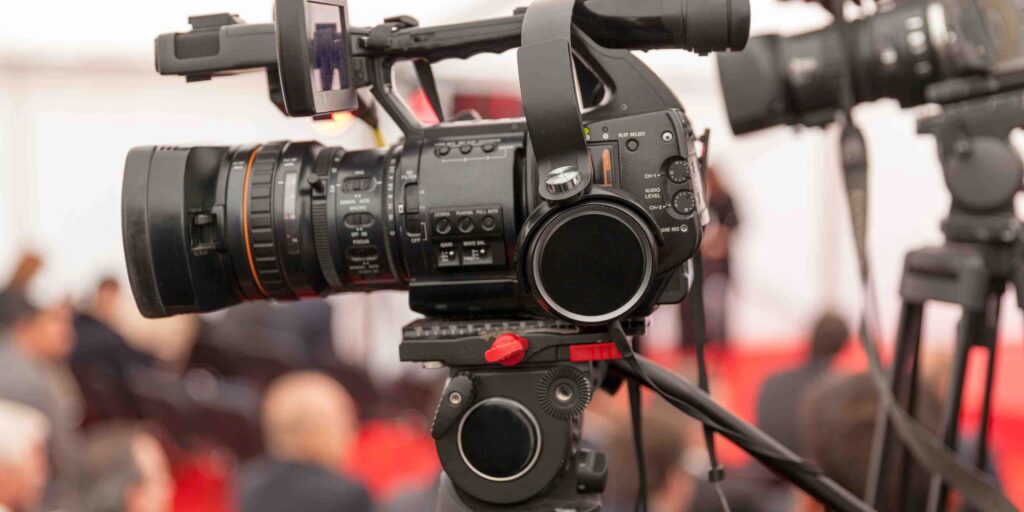 May 2, 2023 by thilina |
live streaming in singapore
May 2, 2023 by thilina |
live streaming in singaporeLive streaming is becoming an increasingly popular way for businesses to communicate with their customers and reach new audiences. In Singapore, the potential of live streaming is enormous, as it allows companies to not only engage with their current consumer base but also tap into new markets and increase revenue. With professional live streaming services, organisations can share content, conduct interactive meetings, and host virtual events from any location at a fraction of the cost compared to traditional mediums, giving them a competitive edge over other firms.
What is live streaming, and how can it benefit your business?

At its core, live streaming involves broadcasting or sharing audiovisual content in real-time over the internet. This type of media distribution enables users on different platforms like websites, social media channels, or dedicated video platforms to access your content simultaneously, allowing you to experience enhanced engagement levels that would otherwise be impossible through traditional methods such as radio or television broadcasts. By investing in high-quality production values such as professional camera operators and audio equipment, you can provide viewers with an immersive viewing experience that they will remember long after they’ve tuned out from other forms of communication.
Understanding the Benefits of Using Professional Live Streaming Services
When considering launching a live streaming campaign, it pays to invest in professional services, as using the right technology, equipment, and personnel can greatly increase the chances of successfully engaging with your target audience. Professional live streaming services offer a range of options for businesses, from providing high-end production quality streaming for corporate events or product launches to offering lower-budget solutions tailored for individual project requirements.
Setting Up an Optimal Infrastructure for Successful Live Streaming
In order to ensure a successful live stream that engages viewers and produces a smooth viewing experience, you need to first set up an optimal infrastructure. This includes assessing the goal of your live stream and considering factors such as cost-effectiveness and scalability when selecting hardware. For instance, if you are looking at scaling up or eventually hosting large-scale virtual events, investing in servers that can handle increased amounts of traffic would be essential. Additionally, having access to a reliable internet connection and sufficient bandwidth is critical when planning any kind of live video broadcast. This is especially important with content involving two-way communication, such as interviews or webinars, where lag times caused by slow internet connections will result in noticeable disruptions during those conversations, which can detract from the overall viewer experience.
Keeping Audience Engagement High During Livestreaming
Engaging with your audience is key during any live stream, and there are various ways you can do this. To start off, ensure that the content of your broadcast is interesting and relevant to people who may have tuned in, as well as offering viewers some level of interactivity such as taking polls or responding to questions in real-time. Additionally, a combination of visuals, music, and text alongside creative use of graphics can help keep audiences engaged throughout the entirety of the broadcast.
The Latest Trends in Online Video Platforms and Technologies
As technology continues to evolve, so too do online video platforms and the associated technologies used for live streaming. A new trend gaining traction is 5G networks, which offer higher transmission speeds compared to 4G, thereby improving the overall user experience when live streaming from mobile devices such as phones or tablets. Additionally, advancements in hardware such as professional cameras and audio equipment designed specifically for recording high-quality streaming also help businesses create professional broadcasts suitable for a wide range of uses, from corporate events to interactive interviews held over virtual environments.
Utilising social media to enhance live streaming results
In today’s digital era, where attention span has decreased drastically due to an overwhelming abundance of content, it pays off big time if you can use social media platforms such as Twitter or Instagram to promote your live streaming. Leveraging these channels allows you to reach a much broader audience and engage with potential viewers who may not have seen an advertisement or post on other mediums. Additionally, since most people are active on social media sites, it’s quick and easy to create a buzz around upcoming events and provide immediate feedback from viewers during the broadcast, which can in turn lead to increased engagement levels for any given live stream.
Finding the Right Equipment for Your Business’s Needs

Choosing the right equipment when setting up a scalable infrastructure is essential in order to ensure successful broadcasting of content as well as delivering clear visuals and audio that engage your target audience. Depending on project needs, having access to professional cameras along with mobile options capable of shooting 1080p resolutions ensures high production values regardless of location. Furthermore, investing in quality microphones designed specifically for recording video broadcasts helps guarantee crisp audio without noise interference, thus enabling viewers to easily understand what is being discussed and maintain their interest throughout the stream.
How to Optimise Your Video Content for Maximum Success
The quality of any live streaming experience will ultimately depend upon how engaging and informative your content is, so optimising it prior to transmission should always be high on your list of priorities. This includes using techniques such as creating visually appealing backgrounds, adding text and graphics to the stream, or even providing subtitles in multiple languages if necessary—all of which help keep viewers interested in what’s being shown. Additionally, setting realistic expectations prior to broadcasting will also allow you to deliver content that meets these standards and have a better understanding of what works for your target audience when crafting future broadcasts.
Best Practises for Professional Live Stream Production Services
Making sure that each live streaming event is properly planned ahead of time is essential for ensuring maximum success. This starts with having clear objectives, such as deciding on the format and length of broadcasts as well as the resources required during them, so that all personnel involved are aware of their roles before going live. Furthermore, practising with trial runs can help work out any kinks encountered while allowing crew members to familiarise themselves with any new equipment used, thus resulting in higher production values when it comes to actual streaming aimed at an audience.
The Power of Augmented and Virtual Reality in the Field of Live Streaming
Augmented and virtual reality (AR/VR) technology has been gaining traction recently due to its ability to provide an immersive environment enhanced through visuals, making it extremely useful during corporate events or conferences where audience engagement is key. By incorporating AR and VR into a live streaming event, companies can provide viewers with interactive and engaging experiences, allowing them to feel like they are actually working or attending a presentation in person—boosting attendance rates as well as providing an enhanced viewing experience regardless of physical location. Additionally, these technologies also enable individuals who may be unable to attend in person due to disabilities or other commitments to still take part by easily accessing remote streaming through their devices.
Live streaming offers businesses an exciting way to engage customers as well as reach new audiences around the world, making it a great opportunity for organisations looking to tap into different markets without incurring the high costs associated with traditional media channels. With access to professional services and knowledge on how best to use this medium, organisations based in Singapore can gain huge advantages by utilising live streaming services effectively, giving them incredible potential for success both locally and internationally.
FAQs:
Live streaming is quickly becoming a popular way for businesses and content creators to reach new audiences. Singapore has become an attractive option for live streaming services due to its high-speed internet connections and reliable infrastructure. Whether you’re looking for a one-time event or an ongoing solution, there are many benefits associated with live streaming, including increased engagement, cost savings, and convenience. To help answer any questions you might have about professional live streaming services in Singapore, we’ve compiled a list of FAQs to shed some light on the subject.
At Springforest Studio, we provide professional production services so that customers can livestream their events without worrying about technical issues or equipment setup. Our team of experienced professionals can handle everything from pre-production planning all the way through post-event analysis, making it easy to go ‘live’ with confidence. We also offer 3D virtual studio sets, which allow our clients to create immersive experiences at lower costs than traditional video studios.
Yes. Our multi-language support means that your audience will be able to understand your message no matter where they are located. We understand that there is no ‘one size fits all’ approach to live streaming, so we make sure to provide services tailored to our customers’ needs.
Yes, as with any online content, it’s important to be mindful of the local laws and regulations regarding privacy and copyright. In Singapore, the Personal Data Protection Act (PDPA) governs how companies can collect and use personal data—such as IP addresses or email addresses—collected through your livestreaming for marketing purposes. It is also important to ensure that you have permission from anyone appearing in your livestreaming before transmitting their image over the internet.
The type of equipment required for a successful livestream depends on a number of factors, including budget, viewership numbers, and technical requirements. If you’re looking for high-end production values, then professional equipment may be necessary, including cameras, microphones, and software applications. For more basic solutions, such as webinars or conferences, some combination of laptops or desktops plus webcams should suffice. Whatever combination you choose, Springforest Studio can help with the setup and advise on the best equipment for your needs.
Measuring engagement during a live stream is an important way to gauge its success. There are a number of tools available that allow you to track audience behaviour, such as total views, time spent watching, click-through rates, and more. This data can be used to develop targeted content strategies that will help maximise viewer engagement in the future. In addition, many streaming platforms also offer analytics tools that provide real-time feedback about viewership numbers and user activity.
At Springforest Studio, we pride ourselves on providing exceptional customer service both before and after an event takes place. Our team is always on hand should any technical issues arise, including hardware or software problems, so you’ll never have to worry about dealing with them yourself. We’re dedicated to making sure every event runs smoothly so our customers can focus their energy on creating quality content without worrying about glitches or interruptions.
Yes. Our experienced team is familiar with all aspects of virtual studio set production and can help you create an immersive experience for your audience. Whether you’re looking to add a touch of Hollywood glamour or simply want to engage your viewers in new ways, 3D virtual sets could be the perfect solution. We’ll work with you to develop a design concept that fits your needs and budget before following through with the necessary setup and testing procedures.
The frequency of live streaming depends on the goals you are trying to achieve, but generally, it is best practise to have regular sessions so that customers become accustomed to seeing updates from your brand. This will help build trust over time as viewers start recognising both the host and content, which could in turn lead to increased viewership numbers, shares, and comments! In terms of frequency, research has shown that more frequent sessions (2–3 times a week) tend to generate better results than sporadic ones, so keep this in mind when deciding how many live streaming are right for you.
Yes, although livestreaming can be done without incurring extra costs beyond equipment fees, utilising professional services such as Springforest Studio typically comes with additional charges. This could include fees for production services, virtual studio set design and setup, or even licencing costs associated with certain content platforms.
At Springforest Studio, we understand that viewers expect high-quality streaming without any technical glitches or errors, so all our production processes are designed around ensuring this happens. We have a “no shortcuts” policy, which means all aspects of the livestreaming process—from equipment selection to post-production workflow—go through rigorous testing before being released for broadcast. Additionally, our team is available 24/7 should anything unexpected come up during an event that requires support at short notice.
